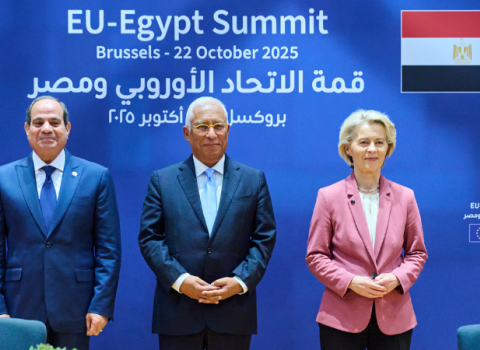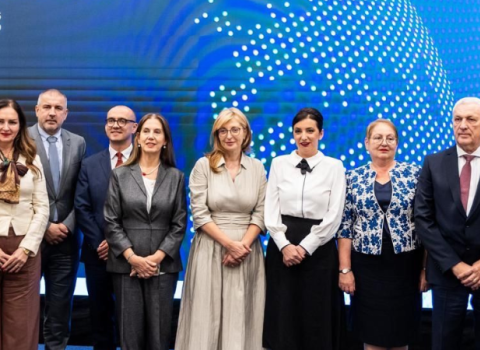With new regulations in the works, chief of staff to EU digital commissioner says Europe can still run the AI race against the US and China – if it can find the money
Kim Jørgensen, European Commission. Photo: Lysiane Pons, Science|Business
Europe can still compete in the global race to commercialise artificial intelligence research, but it needs more money and proportionate regulation, according to Kim Jørgensen, the new head of cabinet to the EU’s digital commissioner Margrethe Vestager.
“We have not lost the battle yet,” Jørgensen said. “The number of AI researchers and centres of excellence based in Europe is actually quite good,” he said. “We simply need to find more money, both from the EU budget and also among companies,” Jørgensen told a Science|Business conference on 4 February.
The commission is due to publish its proposal for regulating AI on 19 February. Jørgensen explained rules are needed to build confidence and ensure risks are properly managed.
But with the EU’s AI hopes pinned on start-ups, while US tech companies and the Chinese state continue to pump huge amounts of money into developing the technology, there are concerns both about what Europe must do to keep up, and if regulation will stifle this emerging high tech sector.
Third way
Nina Kopola, head of Business Finland, the state innovation agency, agreed some regulation is necessary but said, “We cannot have heavy or strict regulation now, because so much is still under development.” Start-ups need the freedom to experiment, even if it is under the vigilant eye of the regulator, she said.
Maria Leitão Marques MEP, vice chair of the European Parliament’s consumer protection committee agreed. What is needed for AI is “a different model of regulation” where the rules are flexible enough to account for rapid change. “AI learning curves are going very fast, and we don’t know exactly what we are going to regulate, so you need something that could be flexible and adaptable,” she said.
The commercial development of AI is in its early days, begging the question of why the commission is stepping in to regulate at this point. Jørgensen said even at this stage there are risks that need to be managed. “The areas of high risk would most probably be health and transport,” he said.
As one case in point, it is important to prevent bias and maintain the “human touch” when developing algorithms intended for use in steering cancer diagnosis and treatment.
Similarly, traffic accidents kill tens of thousands of people in the EU each year, but the prospect of just a single death being caused by a self-driving car means regulation is needed before autonomous vehicles can take to the road. It is not only necessary to understand who is liable, but also how vehicles are programmed to respond in unavoidably lethal situations, when both passengers and pedestrians are at risk. “Those are quite difficult questions that we’ll have to find an answer to,” Jørgensen said.
Skills and money
Added to such ethical imponderables, Europe faces practical challenges in developing and deploying AI. What’s most needed, said Jørgensen, is “skills and money.”
Money is a particular issue in Europe: whereas the US has global giants like Google and Amazon that are making huge investments in AI, the EU is more reliant on capital-starved start-ups to provide the backbone of this emerging sector.
“We are talking about a continent which is much more focused around SMEs and much more focused around manufacturing,” said Volkswagen’s, director of machine learning, Patrick van der Smagt.
Volkswagen can afford to invest in multiple AI projects at once, aware that not all will succeed. But small businesses can’t afford to put hundreds of millions of euros into multiple projects. “For an SME, that’s a totally different story,” van der Smagt said.
Shortage of capital is exacerbating Europe’s AI skills shortages, said Gerrit Schipper, executive director of the Centre for Data Analytics at the Erasmus University in Rotterdam.
“We deprive SMEs of the funds that could have their workforce re-educated, because we give money to all kinds of wonderful projects and research, but SMEs all over Europe sometimes struggle to have their own workforce re-educated and ready for the future,” he said.
Partnerships between industry and academia are seen as one way to bridge the skills gap. For example, Dutch bank ING partners with researchers at TU Delft to develop AI systems for financial services, and to boost digital literacy among its staff. For the academics, the quid pro quo is that they get to work on real life implementations. “We can provide concrete use cases that really bring value [to researchers], and we get access to top talent,” said Marco Li Mandri, head of dialogue analytics at ING
With cutting-edge AI expertise in high demand, universities are losing experienced staff to industry, compromising the quality of student teaching in this subject. Martha Crago, vice pricnipal for research and innovation at McGill University in Montréal, described how a government-funded scheme to retain top academics saw stipends of $75,000 per year paid to professors already earning around $150,000 per year – only for some of them to subsequently be offered $1 million per year jobs at companies like Facebook, Google and Samsung.
“We had to confront this reality: professors that were there to train all the people that all the companies will need in the future, were not going to be in universities anymore,” said Crago. Meanwhile, “student enrolment was galloping”, with the number of student studying computer sciences doubling from 2015 to 2019, while applications rose tenfold in the same period.
That’s not a problem everywhere, however. On a recent visit to China, Crago asked a senior AI professor whether people from his institute were leaving to go into industry. His answer? “They’re not allowed to.’”





 A unique international forum for public research organisations and companies to connect their external engagement with strategic interests around their R&D system.
A unique international forum for public research organisations and companies to connect their external engagement with strategic interests around their R&D system.